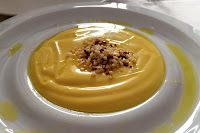Ingredientes
- 1 puerro
- 1 patata (pequeñita)
- 2 calabacines
- Agua
- Aceite de oliva
- Sal
- Pimienta
- Margarina (opcional)
- Jamón cocido (opcional)
1. Rehogamos y cocemos las verduras
Después de lavar, pelar y cortar las tres verduras que vamos a utilizar (puerro, patata y calabacín), se echa un poco de aceite en la olla que vayamos a usar y se rehoga a fuego lento el puerro. Una vez que está blandito, se añaden los trocitos de patata y calabacín, sal y pimienta (al gusto) y se mueven todos los ingredientes unos minutos antes de añadir el agua necesaria para que cuezan nuestras verduras.
2. Batir con cuidado
Una vez que la patata esté blandita, retiramos del fuego y pasamos a batir para obtener la crema de calabacín (con cuidado, para no quemarnos). Hay que tener en cuenta el ir controlando la cantidad de caldo que añadimos a la batidora para que la textura de la crema tenga la consistencia deseada.
Y ahora tenemos dos opciones: Si tenéis demasiada hambruna podéis tomar la crema tal cual, pero si podéis esperar unos minutos más, podéis rehogar en una cacerola un poco de jamón cocido con una "nuez" de margarina para después añadir la crema recién batida, removiéndola a fuego lento para que la margarina se integre perfectamente en el guiso. Con un poco de pimienta por encima, os quedará un plato sabroso y típico de invierno.
Ingredients
- 1 leek
- 1 little potato
- 2 courgette
- Water
- Olive oil
- Salt
- Ground pepper
- Margarine (optional)
- York ham (optional)
Después de lavar, pelar y cortar las tres verduras que vamos a utilizar (puerro, patata y calabacín), se echa un poco de aceite en la olla que vayamos a usar y se rehoga a fuego lento el puerro. Una vez que está blandito, se añaden los trocitos de patata y calabacín, sal y pimienta (al gusto) y se mueven todos los ingredientes unos minutos antes de añadir el agua necesaria para que cuezan nuestras verduras.
2. Batir con cuidado
Una vez que la patata esté blandita, retiramos del fuego y pasamos a batir para obtener la crema de calabacín (con cuidado, para no quemarnos). Hay que tener en cuenta el ir controlando la cantidad de caldo que añadimos a la batidora para que la textura de la crema tenga la consistencia deseada.
Y ahora tenemos dos opciones: Si tenéis demasiada hambruna podéis tomar la crema tal cual, pero si podéis esperar unos minutos más, podéis rehogar en una cacerola un poco de jamón cocido con una "nuez" de margarina para después añadir la crema recién batida, removiéndola a fuego lento para que la margarina se integre perfectamente en el guiso. Con un poco de pimienta por encima, os quedará un plato sabroso y típico de invierno.
************************
- 1 leek
- 1 little potato
- 2 courgette
- Water
- Olive oil
- Salt
- Ground pepper
- Margarine (optional)
- York ham (optional)
1. Lightly fry and boil the vegetables
After cleaning, peeling and cutting the three kind of vegetables we are going to use (leek, potato and courgette), we add a little of olive oil in the pan we are make use to cook, so that, first we lightly fry the leek. Then, once the leek is soft, we add the potato and courgette dices, salt and ground pepper to taste, and we stir everything before pouring the needed water to boil our vegetables.
When the potato is cooked (soft), we remove the pot from the heat, and we use the mixer to form the courgette cream (be careful to avoid burns). Keep in mind that it is necessary to control the quantity of broth we add to the mixer in order to obtain the cream with the desire texture.
To finish there are two options: Obviously, if you are starving, you can delight the cream, but if you can wait some minutes, you can lightly fry York ham with a little of margarine in a pan, and then, the courgette cream should be added in it, stirring everything to integrate the flavour of the margarine in the dish. Season with a little of ground pepper on top, and it's time to enjoy this tasty and typical winter cream.
2. Blend carefully
To finish there are two options: Obviously, if you are starving, you can delight the cream, but if you can wait some minutes, you can lightly fry York ham with a little of margarine in a pan, and then, the courgette cream should be added in it, stirring everything to integrate the flavour of the margarine in the dish. Season with a little of ground pepper on top, and it's time to enjoy this tasty and typical winter cream.




















































